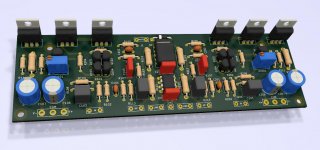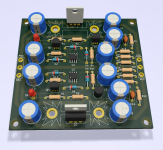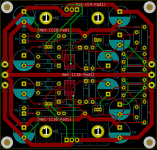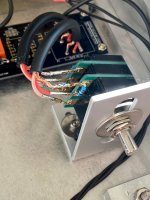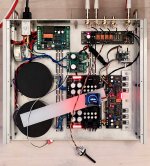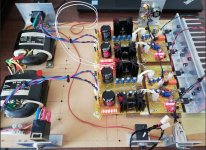Thanks for the info Nick. So it was EMU doing the job. I have the EMU 1212m (basically for measuring) I assume they are pretty much on the same level. I would like to voice equipment with both old and new DACs.
I don't know if you still have Aune, it's good dac with lots of options but not my cup of tea.
It's hard to find a good commercial dac in reasonable amount of money. They exceed in options / display but luck of analog / power supply department.
I assume that DCSTB was the first choice (meaning you haven't tested other things and end up with it).
Looking for boxing mine and mainly because of the problem with heat produced by UBIB/BIB I'm looking for other solutions too.
I tested with bench supply too during development. The first beta was with bib 1.1 also. I knew enough. I wanted to make this preamp friendly to makers in first approach. That is why I also developed a synergistic sounding psu (dcstb) that would automatically work without setup decisions, tweaks, or excessive heat. In the same mentality although I had tried much more expensive JFETs to buy and match I mainly designed around the uPA68 which was forgotten at that time. Cheap and monolithic i.e. accessible with embedded perfect matching.
Knowing that DIYers eventually were going to attempt more lavish builds and where could that go, I focused to make the groundwork solid. Ensuring there was a complete accessible preamp + dual psu base version that has all the right DNA. I always leave to you guys the personal refinement and in your system synergy part of work. If everything is written in stone, no fun.
Mine's EMU Tracker Pre. Over ten years old. I even broke its one channel's balanced function by sticking up rail level DC into it during the breadboard experiments for DCG3 and I had to trace out the interface's pcb to repair it.
Aune usb DAC and nicer headphones I bought later on to exploit DCG3 better, I had a little modded Benchmark DAC1 on the main system at the time. I then sold it cheap to a young guy to use it in his small studio in Chicago for his alternative Rock band recording sessions. The EMU sounds relatively blunt and compressed, it stands nowhere near those DAC machines.
Essential is to know each in hand test system's sound and how it translates widely. No system no matter how expensive to buy or to DIY no matter the effort or inspiration you put in it will ever sound as true as real life.
Hi Pfarrel,
you wrote: TKD linear pot with resistor shunt mod sounds great.
Would you be so kind to explain what is precisely this mod?
Thks
I picked up a TKD linear pot in the swap meet one time for $20. You can make it more "log-like", and "usable", by putting a resistor between wiper and ground—20K pot—I think I used 6.8K? There's a piece of math involved that I can't recall to come up with the resistor value.. I'm sure someone could chime in with more exacting knowledge—I'd read in a few places that such a mod sounds "better" than a like-kind log pot. I can say for my own system—that pot sounded "better" than an Alps blue velvet—and not quiet as sweet as the Muses I eventually added to the preamp I used as a test subject (Aikido). We are talking small, but notable, differences. I did this without making any other changes to the system—over a couple of months.... to see/hear whatever might be different—"good" or "bad". (ignore the temporary looking clip connections—I'm adding a Muses solution to the DCG3—it's a keeper.)
Attachments
You have made your 20k linear pot to a 5k almost logarithmic pot. Because DCG3 on it's own is very fast venturing to few MHz small signal bandwidth, low value pots can allow more RFI in or simply a somewhat fast leading edge feeling on notes. Assuming that a small value pot isn't hard on specific source equipment in the first place. On the other hand less impedance makes hum & buzz noises harder to pick up. Although significant hum fields should not be there in a good build anyway.
Oh man! This is awesome. So, in all likelihood your creation will sound even better? Holy moly. Obviously I'm super fuzzy on all the specifics technically—and whenever the issue of pot value is raised in whatever thread—the answer tends be "well, depends on your source". In my case it's UFSP and an R2R Denafrips DAC (which is the best that I have heard myself, limited at best).... they both sound great—so what do i know!!!!!? Haha.
They both don't have a problem driving 5k for pushing current. The phono has an output buffer stage but it's c4 coupling capacitor surely makies a more aggressive high pass curve now. I expect you to enjoy an even tamer more natural tone when with your muses e-pot installed. More suitable impedance.
Is that a Jung/Didden based PSU?
In principle, yes. It seems likely the circuit as arranged will work properly with a common ground, as well as without remote sensing.
I don't know if this will engender interest, indifference, or indignation, but anyway...
I don't actually have headphones, but I like this circuit and have been thinking about building it for a while. I had bad luck and just missed the most recent group buy. I thought it would make for a good distraction from politics to lay out my own board. I started with the same general component placement but ad-libbed as I went along.
Perusing eBay, I could find no reliable way to identify genuine JFETs. However, I do have a bag of genuine Toshiba 2SK170s in the closet. Seeing that some people have had good luck with them, I decided to make the substitution.
I did not include the relay timer circuit in the interest of flexibility, and to give a more symmetrical layout. I elected to keep a single ground plane, which constrains the power supply options, evidently. This means I will need separate transformers and regulators for each channel.
I did the same thing with the regulator board, starting from Mr. Didden's general layout. My layout is quite similar for the positive side, but I opted for mirror-image symmetry on the negative side, whereas Mr. Didden did not.
I make no claims for the technical merit of my board layouts. Back in the day I would have used point-to-point wiring. But nowadays, designing a PCB is literally the fastest and easiest way to make a prototype, of course.
My birthday is this month. Perhaps I will get myself some headphones.
-Henry
Muses
Pfarrell,
Hopefully it's not confusing to quote one and ask another but what is a good source currently for the muses e-tenuator board, parts, etc. and build instructions/help. No op amp.
I have looked but the threads I saw are lacking build help.
Your DCG3 build build is awesome. (So far). Ha.
Don
They both don't have a problem driving 5k for pushing current. The phono has an output buffer stage but it's c4 coupling capacitor surely makies a more aggressive high pass curve now. I expect you to enjoy an even tamer more natural tone when with your muses e-pot installed. More suitable impedance.
Pfarrell,
Hopefully it's not confusing to quote one and ask another but what is a good source currently for the muses e-tenuator board, parts, etc. and build instructions/help. No op amp.
I have looked but the threads I saw are lacking build help.
Your DCG3 build build is awesome. (So far). Ha.
Don
I understood the goals and details of your dcg3 board art in a quick look, that is why I didn't have further questions. Good luck with your personal build.
Of course. But it occurred to me that others might have been put off by my earlier terse comments.
Given the extraordinary ease of duplicating professional circuit boards nowadays, it surprises me that the Group Buy system persists. It would be simpler just to publish Gerbers and a BOM. I assume the intent is to retain at least a semblance of control over the design. I have no idea if anyone is making money on these group buys, but in case there is any concern, Salas, I have no plans to release my design files. Or certainly not without your approval, as a matter of courtesy.
So, yes, it is my "personal" build, if that is what you were hinting at. Or perhaps I am reading too much into it.
Pfarrell,
Hopefully it's not confusing to quote one and ask another but what is a good source currently for the muses e-tenuator board, parts, etc. and build instructions/help. No op amp.
I have looked but the threads I saw are lacking build help.
Your DCG3 build build is awesome. (So far). Ha.
Don
Don! I built this from Meldano. And the other Muses thread. There's a member Frank Wilker in the threads who hooked me up with the current one here (you could PM him). Yes, to build Meldano's solution you are soldering a bunch of SMD—hardest part is the actual Muses chip. I was pretty fearless and made good use of a fine tip, lots of flux, and solder wick to make nice looking welds, kinda go heavy and then take away with the wick—also if you look at the datasheet for the Muses—it seems VERY hard to kill with heat. Meldano has a good instructional paper on his solution. PM me.
Totally worth it Salas—this Muses business—I can already hear a difference from the 5K lin/log hack pot. Proper listen tomorrow with Ultra! I'm super amped up.
Bad nighttime picture—and I need to extend the cables for the display. Now to build a front. Have a chunk of brass to make a custom volume knob!
Attachments
Last edited:
Hi,
Here is my variation of DCG3. It took me a while to make it, but yesterday evening it played its first sounds. I plan to use it primarily as a headphone amp.
This build uses 2sk170s and bc327s. Initially, I planned to try bc560s first, but after extensive lecture of this thread I decided to go directly to bc327s. The bias is set to 150mA. The DC servo opamp is located at the bottom of the boards.
The amp is arranged as dual-mono with a separate board for each channel. I also use 4-pin XLR connector for my headphones.
I must say, that the whole assembly went very smoothly thanks to excellent manual. There were no problems with firing it up - everything went as expected.
Salas, thank you very much for sharing this project. It's a quality stuff.
Cheers,
F
Here is my variation of DCG3. It took me a while to make it, but yesterday evening it played its first sounds. I plan to use it primarily as a headphone amp.
This build uses 2sk170s and bc327s. Initially, I planned to try bc560s first, but after extensive lecture of this thread I decided to go directly to bc327s. The bias is set to 150mA. The DC servo opamp is located at the bottom of the boards.
The amp is arranged as dual-mono with a separate board for each channel. I also use 4-pin XLR connector for my headphones.
I must say, that the whole assembly went very smoothly thanks to excellent manual. There were no problems with firing it up - everything went as expected.
Salas, thank you very much for sharing this project. It's a quality stuff.
Cheers,
F
Attachments
- Home
- Source & Line
- Analog Line Level
- Salas DCG3 preamp (line & headphone)
